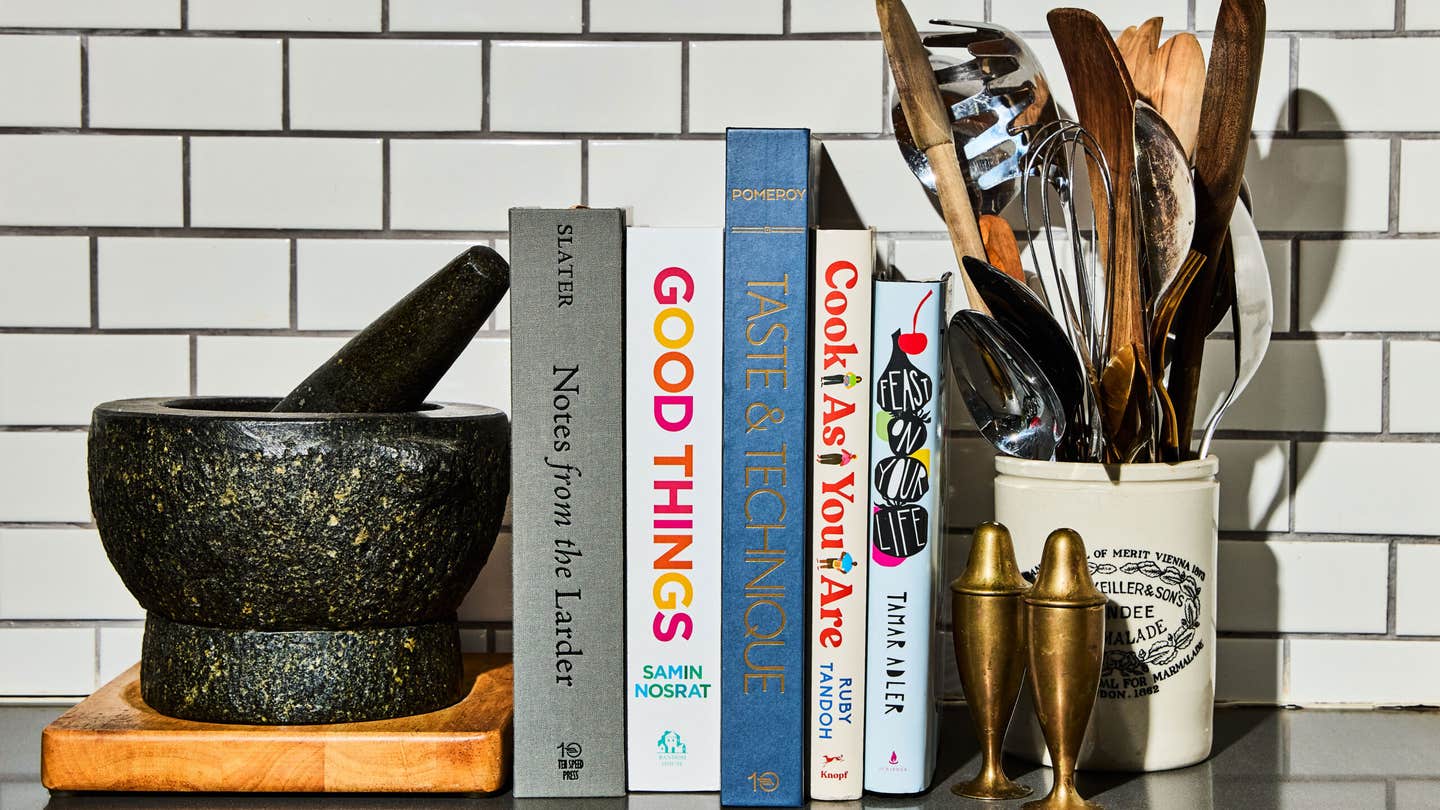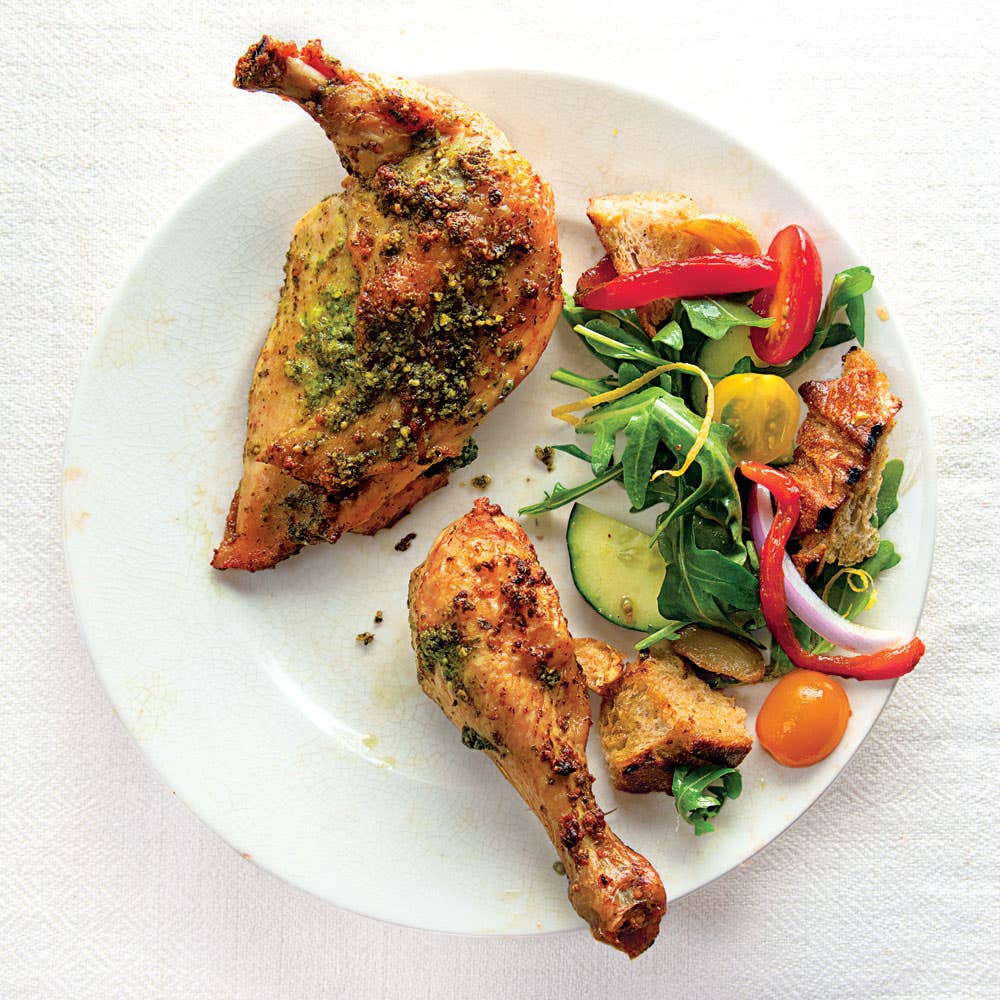
Glorious Pesto: The Uncooked, Economical Pride of Liguria
“What is pesto?” my friend Sergio Rossi asks. He pauses for a moment and then answers his own question. “Pesto is the way a person makes pesto.” It is a riddle for me to decipher as we head a few miles west from Genoa, Italy, to the town of Pra, to find Francesco “Lilli” Ratto, who has been farming here for 60 years. The 76-year-old producer beckons us into his greenhouse, and suddenly we’re amid carpets of tender young basil, a sea of green. The air is filled with such intense perfume it’s hard not to be overcome. For a long time now I’ve been captivated by Genoa, a medieval port city in the northwestern Italian region of Liguria. I love its ancient narrow streets and its inhabitants’ curious French-sounding dialect. I love its traditions of pastas and sauces and vegetable pies called torte. And I love especially the road along the sea with its painted pastel buildings that lead to Recco, the village my great-grandmother left behind when she immigrated to America over a hundred years ago. Each time I visit, I seek out a few more of her recipes in an effort to reclaim a connection to this beautiful place.
This time my focus is pesto. More than a sauce, it's an icon of cultural identity here in Liguria. Just as historically wealthy Bologna has its decadent ragu, slowly simmered to sweetness with rich meat, milk, and wine, Liguria has its divinely aromatic , born of poverty and a resulting dependence on vegetables and gathered greens—uncooked, quick, meatless, economical. The word pesto comes from the verb pestare, which means to step on, or to pound, traditionally in a deep marble mortar using a wooden pestle. Today, the blender is the usual tool of choice, but for those of a certain age in Liguria, the mere sound of pestle striking mortar evokes memories of childhood.
I have no such memories. By the time my multiethnic branch sprouted from the family tree, we were Italian-Americans living in New Jersey, converted to meatballs and marinara. It wasn't until the late 1980s that I first encountered that herbaceous sauce, which—along with sun-dried tomatoes and goat cheese—marked a new American foodie consciousness (see Pesto Goes Global). I slathered it recklessly on anything I could.
**
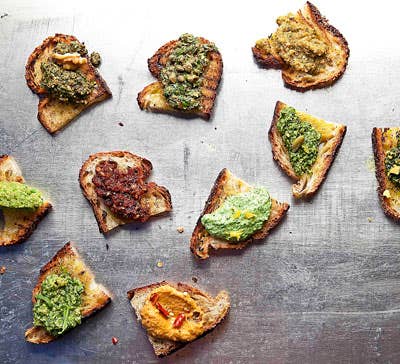
**
Photo: Todd Coleman
Though the sauce had traveled far, the Genoese technique of making it apparently had not. I knew that the minute I first tasted real pesto, tossed with fresh tagliatelle, in Liguria. I was astonished by the bright, light green color resembling spring peas, the creamy texture. The taste was not of garlic or oil, but a complex meeting of sweet, salt, and pungent. I felt blessed to know that this glorious dish and I could be even distantly related. And I desperately wanted to learn how to make pesto this good at home.
In theory, it shouldn't be hard. Pesto genovese has only six ingredients: basil, pine nuts, garlic, salt, cheese, and olive oil (see Elements of Pesto). Yet, like most iconic recipes, this sauce is subject to great debate. How much garlic? How much salt? Which cheese? Should there be visible bits and pieces of basil, or should all of it be pulverized until smooth? The only thing everyone seems to agree upon is that delicate basilico giovane, or young basil, is best, which is why Sergio insisted we begin our exploration of Liguria's famous sauce in Pra, where the most coveted basil for pesto is grown.
In his greenhouse, Lilli reaches down with his beat-up farmers' hands and plucks a tiny basil plant for me to see. "It should have between four and six leaves," he explains. "Six are ideal." Then he pulls up about 30 such plants, each with pale green, teaspoon-size leaves, and gathers them at their roots in a bouquet. He wraps them in paper with the logo of Pra—ready for market. To Americans, who generally grow big bushy basil plants in full sun, raiding the leaves all summer long, this method of pulling up teeny basil plants may seem a bit radical. (See Grow Your Own) But this is how basil has been grown in Liguria for nearly a century, ever since greenhouse technology made it possible for cooks to buy tender young herbs year-round.
I asked Sergio, a local food historian from the Ligurian village of Montaggio, to be my guide on this trip because he knows more about pesto than anyone I have ever met. Shortly after we became friends in 2005, he told me, "Pesto runs through my veins." I believe it. Sergio grew up in his grandparents' restaurant, then spent decades working in the family's Genoa food shop, cooking alongside his mother, who made endless batches of pesto, day after day, to sell to busy home cooks.
In his brief book _Alle Radici del Pesto Genovese (The Roots of Genoese Pesto;_Nova Scripta, 2008), Sergio uses old documents to chart the evolution of pesto from its origins in the 16th century as a vinegar-spiked basil sauce for dressing eggplant to what most people say is the pesto's first recorded recipe, in 1863. He recently unearthed an even earlier verion in a 1618 journal entry from a gentleman in Asti (not far from Liguria's border) who writes of macaroni served with an oil-based sauce of garlic, basil, and cheese—dating pesto even further back than previously known.
Pesto's origins most likely intersect with the many pesto-like sauces found throughout the Mediterranean and beyond: After all, the mortar and pestle is one of the oldest and most ubiquitous cooking tools. The ancient Romans loved their pounded sauces of lovage, parsley, mint, and thyme, and many books about pesto say that it's descended from an old Persian sauce that's made with walnuts and thyme. The Greeks invented skordalia from ground garlic and nuts, and the Spanish have their romesco based on purées of almonds, garlic, red peppers, and olive oil. Even within Italy, there are various pestos, including a Sicilian version that incorporates tomatoes, not to mention the classic salsa verde made of garlic mashed with parsley and other herbs. (See The World of Pesto)
Why did the basil version rise above all others to monopolize the term pesto? And why in Liguria? I can only speculate that because pasta was a great Genoese tradition, and because home cooks there were used to combining it with the garlic and green herbs that grew wild in the hills, pesto was Liguria's destiny.
**
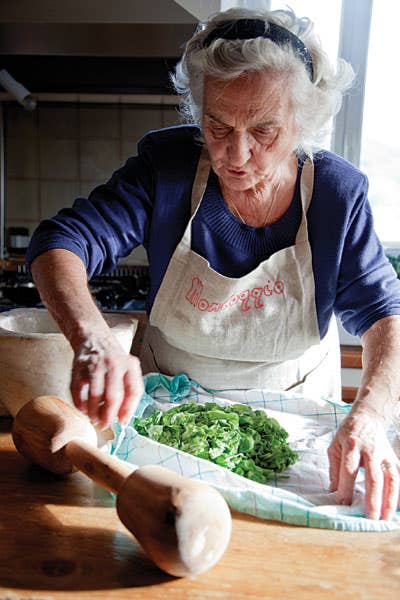
**
Photo: Penny De Los Santos
One of the first things I learned about pesto when I started studying Ligurian food is that it is not used randomly. Sure, you can find the adventurous chef who makes pesto pizza or basil gelato. But these are outliers. For the most part, Ligurian cooks use pesto in two ways: to flavor pasta and to garnish a specific soup.
That soup is minestrone alla Genovese, and it is a staple of daily life—green and dense, entirely vegetarian, made with water, vegetables, potatoes and beans, boiled to a thick and creamy consistency. At the end, you add a bit of pasta and, finally, a generous spoonful of pesto that sends the soup heavenward. This habit is shared by the neighboring French Riviera, where cooks call their pesto pistou, though their version has evolved without nuts and often without cheese, too.
Ligurians use pesto to sauce a local variety of dried fettucine called trenette; fresh tagliatelle, known in dialect as picagge; and its thinner cousin tagliarini, often tossing the pasta with boiled potatoes and string beans. Pesto goes, too, on gnocchi and on a fresh corkscrew pasta called trofie, and also on a unique Genoese style of lasagne, a simple dish of fresh pasta cut into squares, not layered with cheese and baked, but simply tossed with generous amounts of vivid green pesto. It's the brightest tasting comfort food I know.
After leaving Lilli, Sergio and I negotiate the swoops and turns of Liguria's mountains to find a restaurant that he believes serves some of the region's best pesto. He parks us at Osteria Baccicin du Caru, founded in 1890 and today run by Gianni Bruzzone, a slim, reserved man who still insists on making his signature sauce with a mortar and pestle.
"Thirty-five percent of the ingredients should be basil," Bruzzone says while gently pounding garlic with his heavy pestle in his kitchen. He explains that the mortar method is superior because it gently coaxes the essential oils from the basil leaves, as opposed to the tearing action of a blender blade. Bruzzone's mortar is classic Genoese style: six inches deep with four "ears" spaced around the lip and used as handles, which he grabs onto so he can rotate the bowl with one hand while pounding with the other. He tells me that the sequence of ingredients matters: He begins with garlic, then adds pine nuts, then basil, then coarse sea salt (which helps crush the leaves). After a few minutes the leaves start to break apart and the beginnings of a sauce emerge. In goes a stream of oil, and the sauce becomes silky. The cheese is last, and it gives body and creaminess—first Parmigiano-Reggiano, and then some aged pecorino at the end, for bite. "Pesto should be delicate, but decisive," he says.
Bruzzone disappears and returns with boiled potato gnocchi, which he transfers directly into the mortar, mixes with the sauce, and spoons onto our plates. The gnocchi is tender, and the pesto, though vibrant and herbaceous, has a punch of garlic and salt. All of its elements are elegantly balanced.
Bruzzone's osteria is the type of place that Genoa's traditionalists hold dear. True pesto is a point of pride—don't even get people like Sergio started on the multinational corporations that sell inferior products under the name pesto genovese. In 1992, a group of local businessmen created the Order of the Pesto Brotherhood, whose cavalieri teach and promote authentic pesto and give their stamp of approval to places like Osteria Baccicin du Caru. To the same end, the region of Liguria sought—and recently won—D.O.P. status (Denominazione di Origine Protetta) for Genoese basil, which means it's the only product that legally can bear that name. And purists argue that authentic pesto genovese must be made with this D.O.P. basil.
Ironically, though, records show that in the past, pesto was sometimes made with substitutions like parsley and marjoram, even butter, in Liguria. People in the mountains added cream from their cows; in certain coastal towns pesto contained (and still does) a bit of tangy local fresh cheese called prescinseua. And while many people today prefer and can afford Parmigiano's delicate flavor, the grandmothers usually used salty pecorino in their pesto because the cheese that came on boats from Sardinia was far more accessible and cheaper than that which came across mountain roads from Parma. Similarly, local walnuts were common instead of pignoli from Pisa, which became the norm after the second World War, when more people could afford to put pricier ingredients in their pesto. Before that, Sergio says, "People used what they had."
**
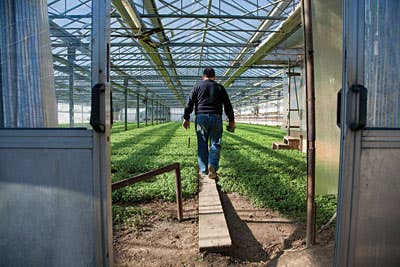
**
Photo: Penny De Los Santos
The next day, Sergio offers to show me how to make the typical pastas that go with pesto. He drives me an hour north of Genoa to the mountain village of Montoggio where his 82-year-old mother, Enrichetta, is cracking eggs and dropping the yolks into the cratered mountain of flour on her pasta board. A professional cook since the age of 12, she moves with power, and within minutes she is kneading dough and transforming it into a thin sheet of pasta with a rolling pin.
Enrichetta cuts half the dough into squares for lasagne, the rest into ribbons, for tagliatelle. Sergio makes gnocchi by mashing steaming hot potatos through a ricer and mixing in flour and egg; together, we roll the dough into long cylinders and slice off thumbnail-size pieces.
Because pesto has been a way of life for Sergio since he was a child, he has no nostalgia. That's why when I ask, "Is there really a difference between the mortar and the blender?" I know I am baiting him. His answer: "I'd rather have pesto made by a good cook in a blender than pesto made by a bad cook in a mortar." Then he adds, "You don't still wash your clothes in a river, do you?"
First we make pesto in a mortar, using Lilli's basil. Enrichetta insists that garlic goes in after the rest of the ingredients, to prevent bitterness. Handing me the pestle, she tells me to pound toward the center and rotate the mortar clockwise as I go. Before long, and with not a little bit of muscle, the leaves and cheese and nuts and garlic magically transform into a verdant cream.For the next batch, the same ingredients go into the blender, which Enrichetta plays like an instrument, repeatedly stopping it to press down the contents with a spatula. The result is smooth if not quite as luxurious and creamy as the traditional method. Still, I have to admit the blender version is exceptionally good.
As we sit to eat, Enrichetta's pestos strike me as every bit as perfect as Gianni Bruzzone's. But they are different—silkier. I am not quite sure why, but I know now that each and every pesto is unique. Each one is an expression of its maker. I have deciphered Sergio's riddle. Pesto is indeed the way a person makes pesto.
Keep Reading
Continue to Next Story









